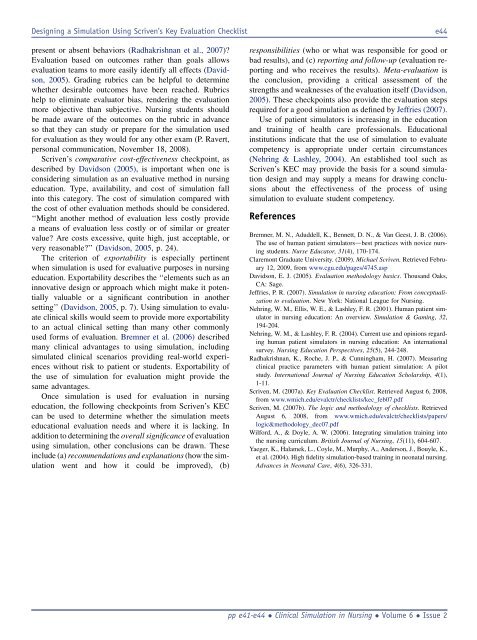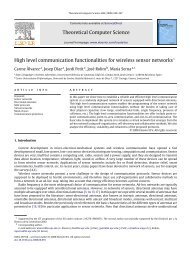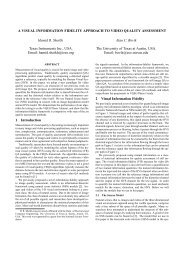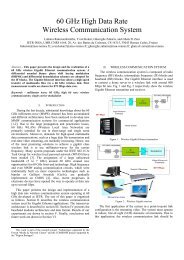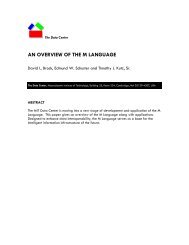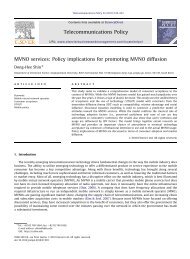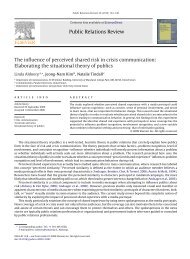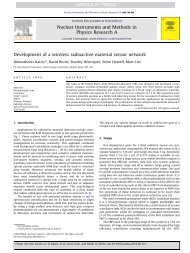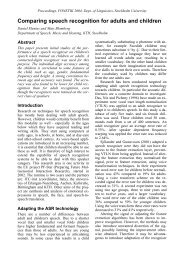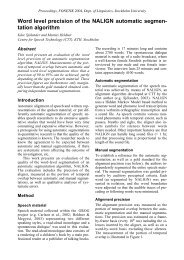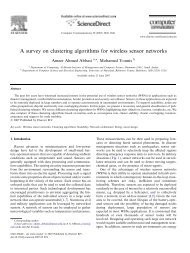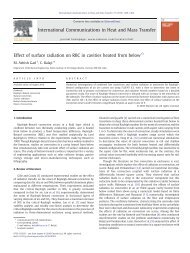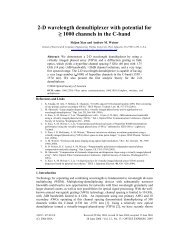Designing a Simulation for Student Evaluation Using Scriven's Key ...
Designing a Simulation for Student Evaluation Using Scriven's Key ...
Designing a Simulation for Student Evaluation Using Scriven's Key ...
You also want an ePaper? Increase the reach of your titles
YUMPU automatically turns print PDFs into web optimized ePapers that Google loves.
<strong>Designing</strong> a <strong>Simulation</strong> <strong>Using</strong> Scriven’s <strong>Key</strong> <strong>Evaluation</strong> Checklist e44<br />
present or absent behaviors (Radhakrishnan et al., 2007)?<br />
<strong>Evaluation</strong> based on outcomes rather than goals allows<br />
evaluation teams to more easily identify all effects (Davidson,<br />
2005). Grading rubrics can be helpful to determine<br />
whether desirable outcomes have been reached. Rubrics<br />
help to eliminate evaluator bias, rendering the evaluation<br />
more objective than subjective. Nursing students should<br />
be made aware of the outcomes on the rubric in advance<br />
so that they can study or prepare <strong>for</strong> the simulation used<br />
<strong>for</strong> evaluation as they would <strong>for</strong> any other exam (P. Ravert,<br />
personal communication, November 18, 2008).<br />
Scriven’s comparative cost-effectiveness checkpoint, as<br />
described by Davidson (2005), is important when one is<br />
considering simulation as an evaluative method in nursing<br />
education. Type, availability, and cost of simulation fall<br />
into this category. The cost of simulation compared with<br />
the cost of other evaluation methods should be considered.<br />
‘‘Might another method of evaluation less costly provide<br />
a means of evaluation less costly or of similar or greater<br />
value? Are costs excessive, quite high, just acceptable, or<br />
very reasonable?’’ (Davidson, 2005, p. 24).<br />
The criterion of exportability is especially pertinent<br />
when simulation is used <strong>for</strong> evaluative purposes in nursing<br />
education. Exportability describes the ‘‘elements such as an<br />
innovative design or approach which might make it potentially<br />
valuable or a significant contribution in another<br />
setting’’ (Davidson, 2005, p. 7). <strong>Using</strong> simulation to evaluate<br />
clinical skills would seem to provide more exportability<br />
to an actual clinical setting than many other commonly<br />
used <strong>for</strong>ms of evaluation. Bremner et al. (2006) described<br />
many clinical advantages to using simulation, including<br />
simulated clinical scenarios providing real-world experiences<br />
without risk to patient or students. Exportability of<br />
the use of simulation <strong>for</strong> evaluation might provide the<br />
same advantages.<br />
Once simulation is used <strong>for</strong> evaluation in nursing<br />
education, the following checkpoints from Scriven’s KEC<br />
can be used to determine whether the simulation meets<br />
educational evaluation needs and where it is lacking. In<br />
addition to determining the overall significance of evaluation<br />
using simulation, other conclusions can be drawn. These<br />
include (a) recommendations and explanations (how the simulation<br />
went and how it could be improved), (b)<br />
responsibilities (who or what was responsible <strong>for</strong> good or<br />
bad results), and (c) reporting and follow-up (evaluation reporting<br />
and who receives the results). Meta-evaluation is<br />
the conclusion, providing a critical assessment of the<br />
strengths and weaknesses of the evaluation itself (Davidson,<br />
2005). These checkpoints also provide the evaluation steps<br />
required <strong>for</strong> a good simulation as defined by Jeffries (2007).<br />
Use of patient simulators is increasing in the education<br />
and training of health care professionals. Educational<br />
institutions indicate that the use of simulation to evaluate<br />
competency is appropriate under certain circumstances<br />
(Nehring & Lashley, 2004). An established tool such as<br />
Scriven’s KEC may provide the basis <strong>for</strong> a sound simulation<br />
design and may supply a means <strong>for</strong> drawing conclusions<br />
about the effectiveness of the process of using<br />
simulation to evaluate student competency.<br />
References<br />
Bremner, M. N., Aduddell, K., Bennett, D. N., & Van Geest, J. B. (2006).<br />
The use of human patient simulatorsdbest practices with novice nursing<br />
students. Nurse Educator, 31(4), 170-174.<br />
Claremont Graduate University. (2009). Michael Scriven. Retrieved February<br />
12, 2009, from www.cgu.edu/pages/4745.asp<br />
Davidson, E. J. (2005). <strong>Evaluation</strong> methodology basics. Thousand Oaks,<br />
CA: Sage.<br />
Jeffries, P. R. (2007). <strong>Simulation</strong> in nursing education: From conceptualization<br />
to evaluation. New York: National League <strong>for</strong> Nursing.<br />
Nehring, W. M., Ellis, W. E., & Lashley, F. R. (2001). Human patient simulator<br />
in nursing education: An overview. <strong>Simulation</strong> & Gaming, 32,<br />
194-204.<br />
Nehring, W. M., & Lashley, F. R. (2004). Current use and opinions regarding<br />
human patient simulators in nursing education: An international<br />
survey. Nursing Education Perspectives, 25(5), 244-248.<br />
Radhakrishnan, K., Roche, J. P., & Cunningham, H. (2007). Measuring<br />
clinical practice parameters with human patient simulation: A pilot<br />
study. International Journal of Nursing Education Scholarship, 4(1),<br />
1-11.<br />
Scriven, M. (2007a). <strong>Key</strong> <strong>Evaluation</strong> Checklist. Retrieved August 6, 2008,<br />
from www.wmich.edu/evalctr/checklists/kec_feb07.pdf<br />
Scriven, M. (2007b). The logic and methodology of checklists. Retrieved<br />
August 6, 2008, from www.wmich.edu/evalctr/checklists/papers/<br />
logic&methodology_dec07.pdf<br />
Wil<strong>for</strong>d, A., & Doyle, A. W. (2006). Integrating simulation training into<br />
the nursing curriculum. British Journal of Nursing, 15(11), 604-607.<br />
Yaeger, K., Halamek, L., Coyle, M., Murphy, A., Anderson, J., Bouyle, K.,<br />
et al. (2004). High fidelity simulation-based training in neonatal nursing.<br />
Advances in Neonatal Care, 4(6), 326-331.<br />
pp e41-e44 Clinical <strong>Simulation</strong> in Nursing Volume 6 Issue 2


